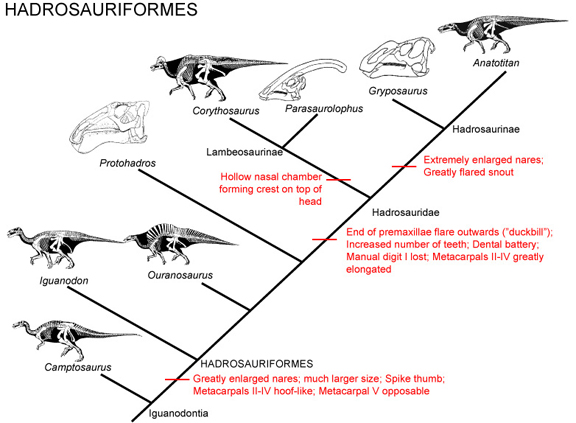Early ornithopods small (1 m long) bipedal animals; later forms increase in size and
retain bipedality, but develop more sophisticated chewing jaws

Ornithopods and marginocephalians are sister taxa within Ornithischia: both have gap between
premaxillary and maxillary teeth and enlarged predentaries, among other features.
This distinguishes them from primitive ornithischians (e.g., Pisanosaurus,
Lesothosaurus) and thyreophorans.
Many bipedal ornithischians (Lesothosaurus, Scutellosaurus, heterodontosaurids,
psittacosaurids, pachycepholosaurs) were once placed in Ornithopoda, but this was mostly because of the
primitive retention of a bipedal gait.
Ornithopods include a series of primitive forms (which some have grouped into Hypsilophodontia:
almost certainly a paraphyletic series) and the larger Iguanodontia
"Hypsilophodonts"
- Mostly small (1-3 m long), obligate bipeds
- Probably fast runners
- Earliest forms in Middle Jurassic, persist until end of Cretaceous
- Now appear to be several distinct lineages, including Late Jurassic Othnielosaurus,
Early Cretaceous Hypsilophodontidae, Late Cretaceous Thescelosauridae, among many others
- Most famous representative is the hypsilophodontid Hypsilophodon of the Early Cretaceous of
Europe and North America and Early Cretaceous Australian Leaellynasaura (star of an
episode of Walking With Dinosaurs)
Iguanodonts
- Almost all are larger than "hypsilophodonts"
- Most have stout forelimbs, and were probably facultative bipeds
- Used hindlimbs only when running and feeding on trees
- Used all four while walking and when browsing on low vegetation
- Characterized by loss of premaxillary teeth
- Most iguanodonts also have enlarged nares, and more advanced ones have well-developed
cranial hinges
- Earliest are in Middle Jurassic, but become more common in Late Jurassic and Early
Cretaceous
- Among the most famous are Camptosaurus of the Late Jurassic of western North
America (and possibly Europe) and Tenontosaurus of the Early Cretaceous of
western North America
The larger and more specialized iguanodonts form a clade, Hadrosauriformes:

Hadrosauriforms:
- Generally quite large, 7-14 m long
- Spent a lot of time on all fours
- Nares were large
- Manus was highly specialized:
- Digit I formed a conical spike
- Digit V was long and opposable
- Metacarpals II-IV were long
- Digits II-IV were hoof-like
- Jaws and teeth were also highly specialized
- Teeth are found only in back half of jaws
- Early Cretaceous hadrosauriforms include Iguanodon of Europe (and possibly Asia);
the gracile Mantellisaurus of Europe (for more than a century and a half considered a
species of Iguanodon; Ouranosaurus of northern Africa (with extremely tall neural spines:
possibly for display and/or thermoregulation); and Protohadros of North America (probable
sister group of Hadrosauridae, the most specialized of all ornithopods)
Hadrosaurids, or "duckbills":
- EXTREMELY common in Late Cretaceous of North America, somewhat less common but present
in Asia, Europe, South America
- One of the most common plant eaters in Late K: known from eggs through adults
- At least some species lived in herds and had nesting colonies
- Many distinguishing features, including:
- End of snout flares outward to form "duck bill"
- Huge increase in number of teeth
- Teeth organized into dental battery: a continuous grinding surface
- Allowed the most complex and sophisticated chewing of any reptile
- Comparable to the chewing ability in modern herd mammals
- Manual digit I lost
- Metacarpals II-IV very long and slender: probably spent most of the time on all
fours
Hadrosaurids are divided into two main clades:
- Hadrosaurinae, characterized by enlarged external nares and broader
snouts
- Lambeosaurinae, characterized by hollow crests on top of head
- These crests house the nasal passage
- Debate on possible uses of lambeosaurine crests:
- Increase surface area for smelling sensors
- Sound generation (equivalent to woodwind or brass instrument)
- Visual display
- Trapping moisture in exhaling breath to keep lungs from drying out
- Or a combination
- Lambeosaurine crests vary from species to species, and from sex to sex
- Babies, males, and females of a species were often once classified as different species
- Most baby lambeosaurines look alike: their distinctive crests only show up when they
were almost full grown
To Next Lecture.
To Previous Lecture.
To Syllabus.
Last modified: 11 January 2007


